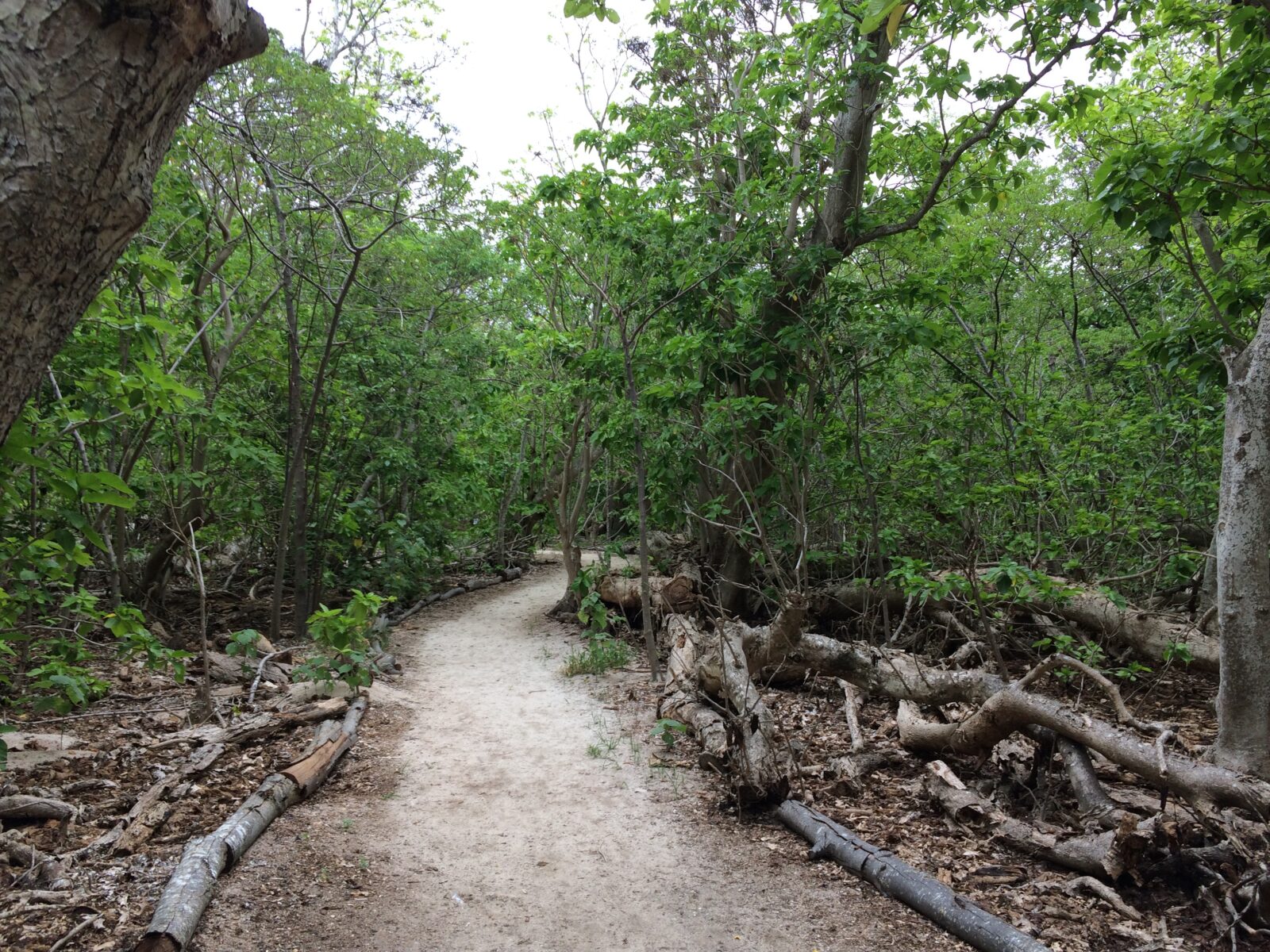I travel to Heron island in late January 2020. Australia is on fire, and I have the means to escape the smoke that has been choking Canberra since November. My world has narrowed to scanning the real-time air quality index for the brief moments safe enough to take my baby son outside. I have become anxious, filled with dread by the future this portends. I want to switch off completely, before my brain short-circuits.
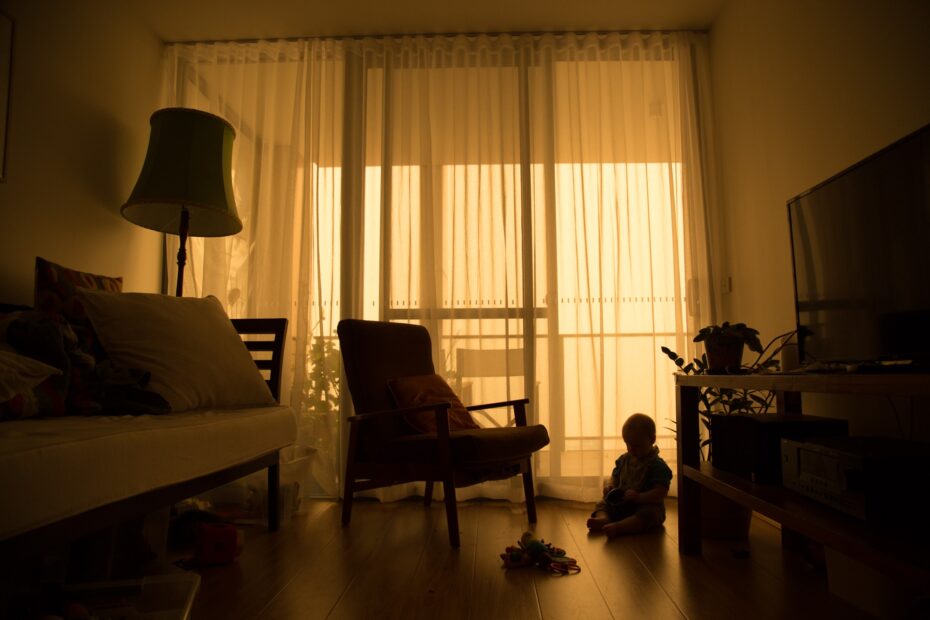
Sheltering in our apartment on one of the worst days of smoke. Photo by Simon Cunich.
What I don’t know is that January is breeding season on Heron Island, and we will be sharing the place with 200,000 birds. When we arrive, I cannot switch off, because I am hit by a wall of incessant bird noise and the stench of ammonia. I am also hit by bird shit. Twice in the first hour. Even worse, on the first night I wake countless times hearing my baby crying, only to find him fast asleep. Am I losing my mind? On the way to breakfast, I am informed by a fellow mother staying at the resort that the call of the nocturnal, burrow-nesting shearwaters is exactly like a crying baby. I’m not the only parent losing sleep.
It is very painful to admit to myself that, card-carrying nature-lover though I profess to be, I am not loving the birds. Right now, I wish them gone. Over breakfast, Justin Timberlake’s ‘Sexy Back’ blasts incongruously from the speakers as families queue for the buffet and kids eat their Cocopops. Nickleback follows, as it will every day for the next week. My son throws his food all over the floor and buff-banded rails hurry over to eat the scraps, despite the wall-to-wall screening to keep them out. The vibe is bizarro early 2000’s family holiday meets The Birds.
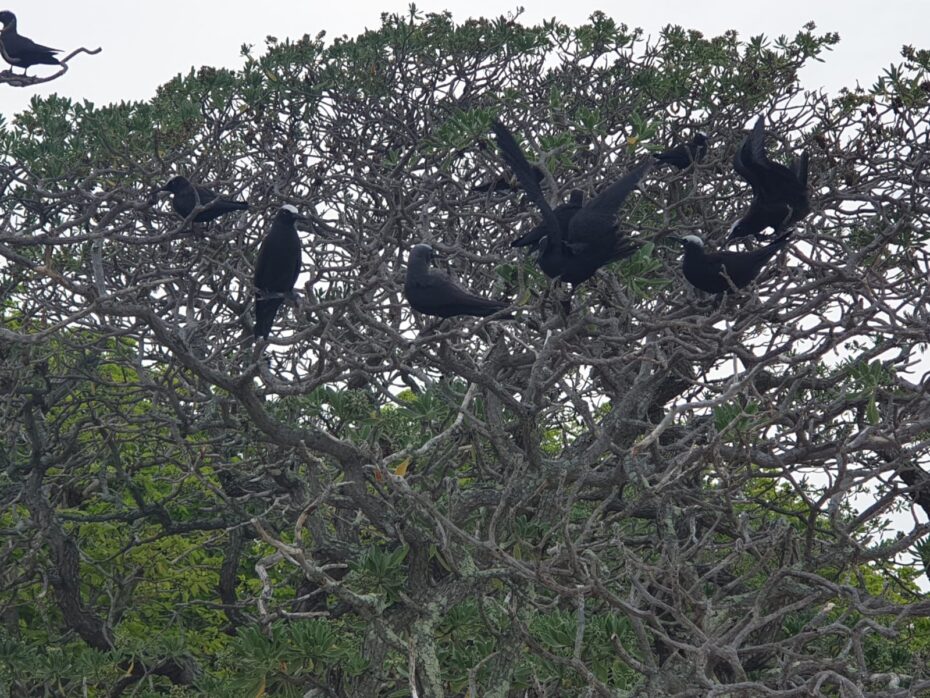
Black noddy terns at dusk.
But as day two progresses, my brittle, smoke-addled mind begins to decompress. I remember that nature doesn’t exist for my convenience or gratification and may include bird shit. I am begrudgingly won over by the chattering black noddy terns roosting in the branches surrounding our room. Over the coming days, every waking moment becomes a nature documentary. My son spends so much time gazing in fascination at the noddy terns that halfway through our stay, he pronounces his first word – ‘bird’.
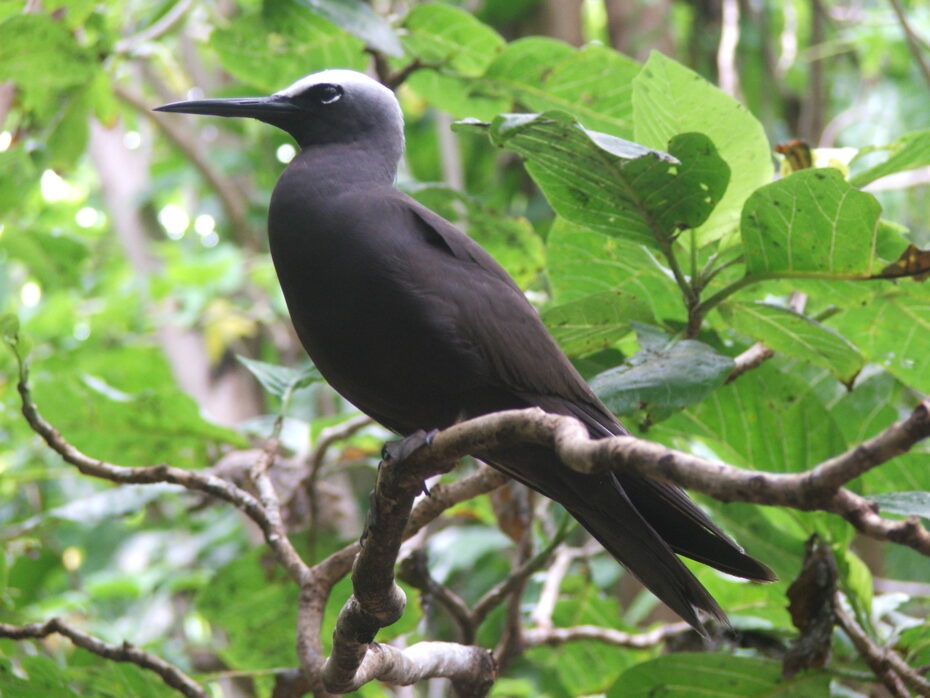
One of Heron Island’s black noddy terns. Photo by Sirrob01
The omnipresence of the birds, in fact, suggest something that has become rare in the Anthropocene; a place where wildlife is not just surviving in the margins, but thriving in abundance. And it is the wildlife, rather than the slightly tired resort, that is the main attraction on Heron Island. Apart from the birds, turtles, sharks, rays and fish abound. From June to September, you can also see migrating humpback whales.
Each night, green turtles and the occasional loggerhead heave themselves up the beach to nest. There is no moon, and torches are banned for reasons I’ll explain later, so I sit silently behind them in the sand, listening to their flippers dig and scrape against tree roots. In the darkness, the sounds of the turtles breathing and grunting in their nesting trance are amplified.
My baby wakes me up at dawn each morning, which is 4.30 AM. This would be painful, except it is the perfect time to observe turtles returning to the water after nesting overnight. The turtle mamas leave huge tracks down the beach, marking their laboured journey. Sometimes they must cross rocky shelves up to a metre high, with the tide having receded since they left the water overnight. It seems an impossible task, but they scrape their huge bodies over the rock and propel themselves up and over the walls. We’re told that the turtles desperately need to conserve energy, so we can’t afford to disturb them. We stay behind the turtles and out of their line of sight at all times. Sometimes this means stopping altogether and waiting until the turtle is far enough down the beach to safely pass behind.
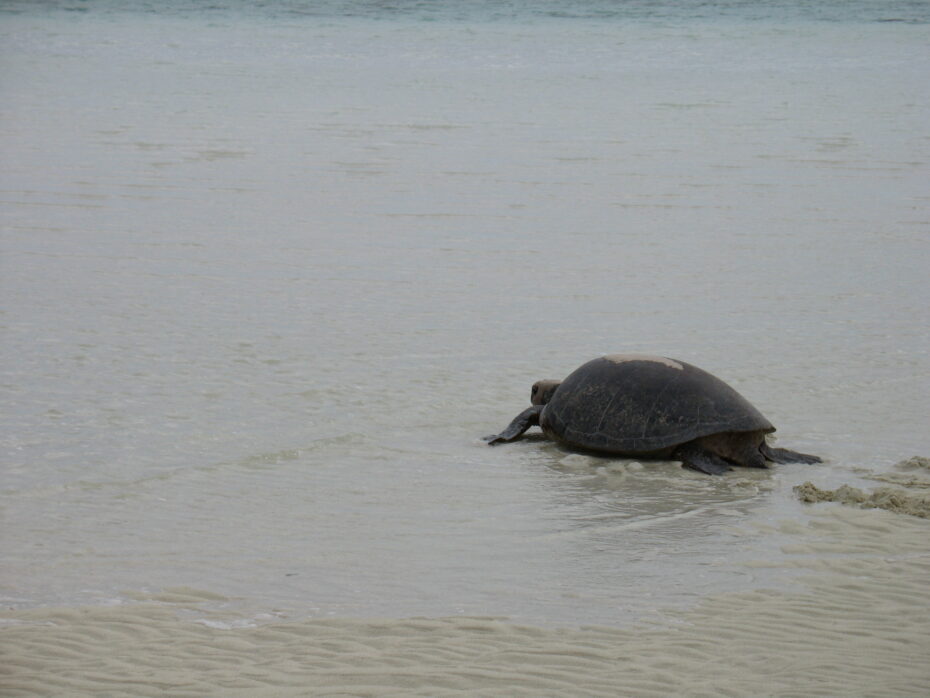
A turtle returns to the water early in the morning after nesting. Photo by BenAveling.
Volunteers from the Heron Island research station tell us when all the eggs from a turtle nest hatch at once, the babies bubble out of the sand like popcorn. At sunrise, we walk the perimeter of the island, and find baby turtles making their desperate dash to the water whilst gulls snatch stragglers. Guests try to shepherd the hatchlings down the beach, keeping the predatory birds at bay. Intervention in the natural order, but then again there are more gulls on the island than there would naturally be, due to the resort.
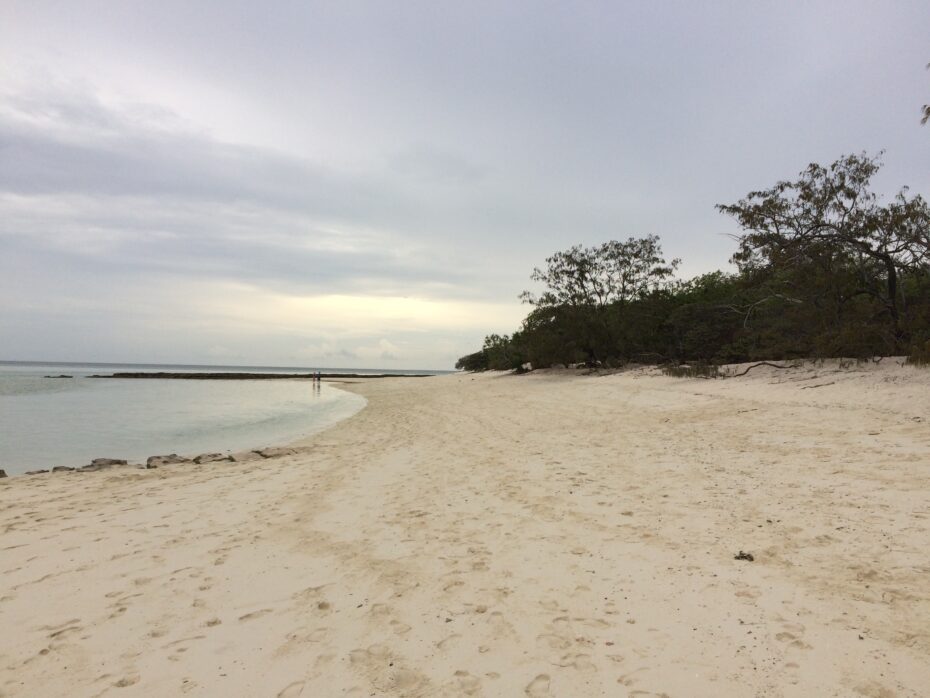
Walking the island’s perimeter.
At night, the resort lights bewitch some hatchlings, and I nearly step on one as we are returning from dinner. It is swiftly removed from our custody and placed in a bucket by a research student from the UK who, like a pied piper, is followed by a gang of holidaying kids. We follow too, down to the beach, where the turtles are placed on the sand and encouraged to make their own way to the water. This journey to the water is thought to be an important part of their magnetic orientation, which will eventually guide them back to the exact site where they have hatched, to mate and nest. But this won’t be for another thirty years. And only a tiny proportion – 1 in 1,000 – will survive this long.
Artificial lights are a huge threat to turtles, disorienting babies and making them vulnerable to exhaustion, dehydration and predation. Light from human settlements also deters female turtles from nesting in the first place. On Heron Island, the outdoor lighting is orange, as this affects turtles less than blue-wavelength light. Stickers in each room remind guests to close their heavy blinds if using lights at night, though not everyone follows the rules. It seems that most hatchlings manage despite the resort’s lighting, but humans have an impact everywhere we go. I am reminded that in seeking out this island paradise, we are altering it.
With a little person to take care of, I can’t spend much time under the water. But there are ways around this. Reef walks make it possible to explore the underwater world with my son snuggled against my chest in the baby carrier. At low tide, we wind our way through a coral maze out towards the open ocean, marvelling as little epaulette sharks dart beside us, long and lithe. Walking the beaches in the early morning and late afternoon, we also see little black-tipped reef sharks and rays metres from us in the clear shallow water, hoping to feast on turtle hatchlings. The aquatic life is so abundant here you don’t actually need to be in the water to experience it.
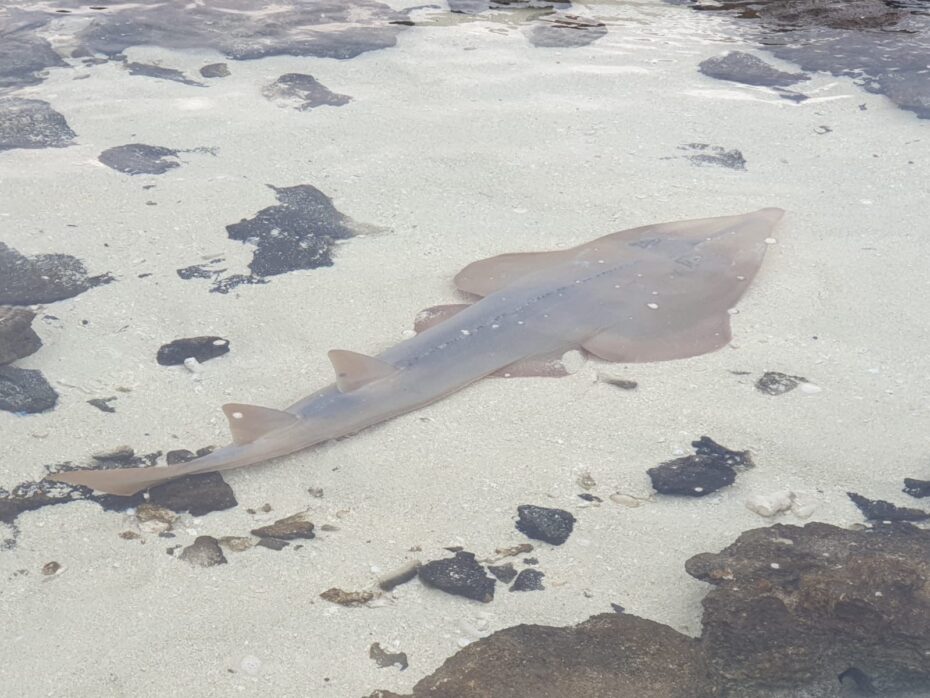
A shovel-nosed ray cruises the shallows beside us.
There is one other way to get underwater with a baby. We take a tour in an old-school semi-submersible boat and peer out the windows at underwater coral gardens. I feel like I am in The Life Aquatic and Bill Murray will emerge from above deck at any moment in a red beanie, to point out the jaguar shark. Impervious to the turtles and rays that glide alongside us, my son devotes his rapt attention to the bolts on the windows.
I do get the chance to snorkel, too. It’s the best snorkelling I’ve ever done in the category of ‘big things under the water’. Off the jetty I swim with parrot fish, giant guitarfish (or shovel-nosed rays), tens of huge stingrays, and once, am jolted with a thrill as a large lemon shark cruises past me. On one swim, a fellow snorkeller tries to point out something to me. I stare blankly, until eventually, the outline of an ornate tasselled wobbegong shark appears from the coral like a Magic Eye optical illusion.
Another day, I take a short boat trip out to the bommie reef, where I float through hyperspace in a huge ball of bait fish and watch groups of turtles resting and grazing on the reef below me. Returning to the boat, a large crescent-shaped creature arcs towards us and then away into the deep blue. Suddenly, our group is surrounded by devil rays, spiralling around us in a frenetic, alien dance. And then, as quickly as they arrived, they are gone.
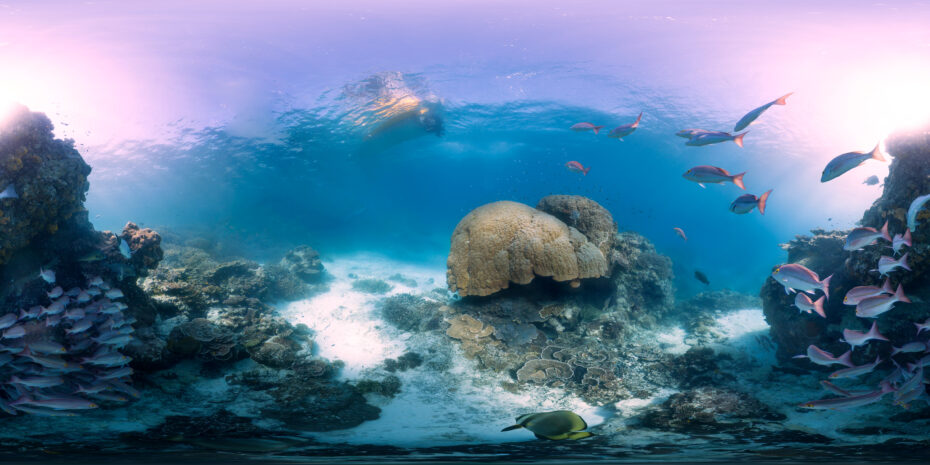
Heron Island bommie. Photo © Underwater Earth / XL Catlin Seaview Survey / Christophe Bailhache
I came to Heron island to escape reality, but with a reckoning coming on a planetary scale, there’s nowhere left to hide – not even paradise. The water off the jetty is so warm some afternoons that I know in-shore coral are being bleached right there, in front of my eyes. By the end of this summer, scientists will confirm that the southern Great Barrier Reef, including Heron island, has suffered significant, widespread bleaching. They will describe it as an underwater bushfire.
The island feels somehow magical and chimeric. It reminds me of the strange, carnivorous island from Life of Pi. In that book, after almost succumbing to starvation and thirst, the shipwrecked Pi washes up on a terrain unaccountably covered in forest, fresh water pools and meercats. But at night, the pools become acidic, killing anything unlucky enough to fall in. Heron Island’s forest of lush, towering Pisonia trees seems similarly impossible on this tiny coral cay. And this island is carnivorous too. The Pisonia trees have sticky seeds, that catch in the feathers of the noddy terns. Some birds become so heavy with seeds that they can no longer fly, and fall to the earth to die a slow death of starvation. Their decaying bodies build the soil, fertilising the Pisonia trees.
Life finds a way.
This island was born out of the ocean only 6,000 years ago. 1,500 years ago, it began to hold fresh water, making it possible for trees to grow. And now, as the ocean warms and rises, some corals are growing and rising up. Others are dying. I don’t know whether I will be able to take my son snorkelling here when he’s old enough. I don’t know whether this island will soon return to the ocean it emerged from. Its existence has been fleeting in Earth’s timescale, my own lifespan more miniscule still. I suck in the glorious, impermanent wonder of this place, like air.
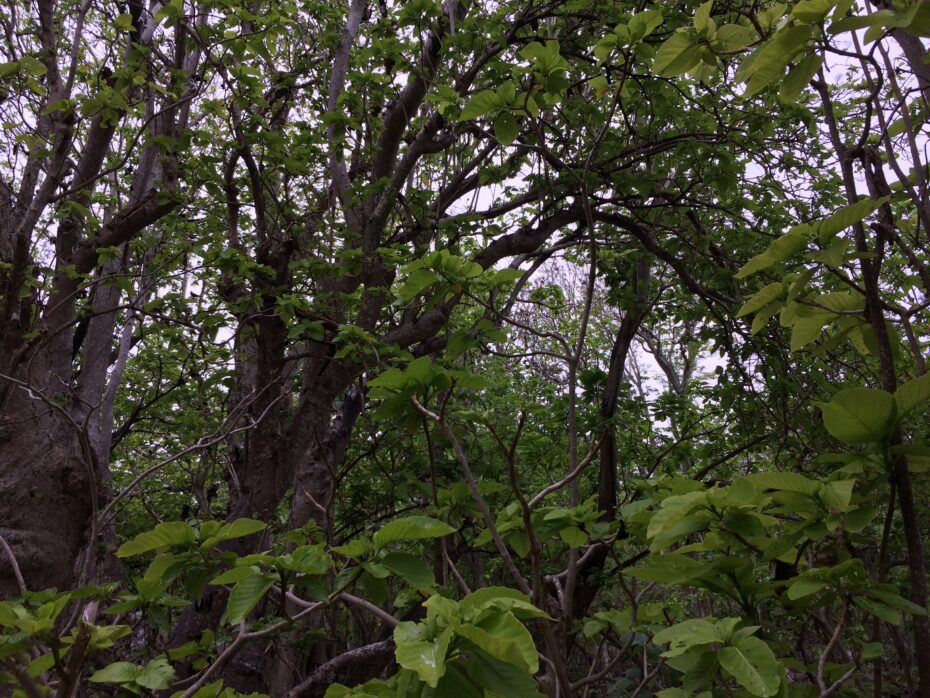
Heron Island’s Pisonia forest as dusk falls.

